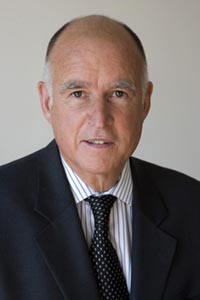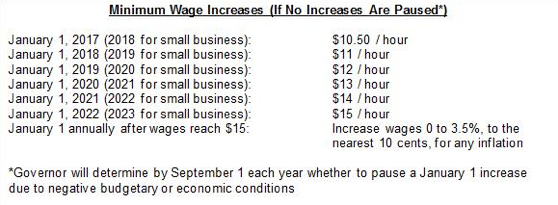Update: Governor signs minimum wage bill
Update posted April 4
‘This is about economic justice, it’s about people,’ said Brown

California Governor Jerry Brown.
–Governor Edmund G. Brown Jr. joined supporters from across the state in Los Angeles to sign legislation that makes California the first state in the nation to commit to raising the minimum wage to $15 per hour statewide.
“This is about economic justice, it’s about people,” said Brown. “This is an important day, it’s not the end of the struggle but it’s a very important step forward.”
Under the legislation, minimum wage will rise to $10.50 per hour on January 1, 2017 for businesses with 26 or more employees, and then rise each year until reaching $15 per hour in 2022. The bill also recognizes the contributions of small businesses – those with 25 or fewer employees – to California’s economy and allows additional time for these employers to phase in the increases.
The legislation increases the minimum wage over time, consistent with economic expansion, while providing safety valves – known as “off-ramps” – to pause wage hikes if negative economic or budgetary conditions emerge. The Governor can act by September 1 of each year to pause the next year’s wage increase for one year if there is a forecasted budget deficit or poor economic conditions.
Once the minimum wage reaches $15 per hour for all businesses, wages could then be increased each year up to 3.5 percent (rounded to the nearest 10 cents) for inflation as measured by the national Consumer Price Index.
It replaces a ballot measure that, if passed, would have raised the minimum wage to $15 by 2021, a year faster.
The new law also phases in sick leave for In-Home Supportive Services workers starting in July 2018.
Governor Brown signed AB 10 in September 2013 to raise California’s minimum wage 25 percent, from $8 to $10 per hour, effective January 1, 2016. There are approximately 7 million hourly workers in California, of which about 2.2 million earn the minimum wage.
A fact sheet on the new legislation can be found here. For full text of the bill, visit: http://leginfo.legislature.ca.gov
Update posted April 1
Bill passes state senate, assembly, will be signed by Governor on Monday
–Governor Edmund G. Brown Jr. will join supporters from across the state on Monday in Los Angeles to sign landmark legislation SB 3, passed by both houses of the legislature Thursday, that makes California the first state in the nation to commit to raising the minimum wage to $15 per hour statewide.
“California is proving once again that it can get things done and help people get ahead,” said Governor Brown when the deal was announced earlier this week. “This plan raises the minimum wage in a careful and responsible way and provides some flexibility if economic and budgetary conditions change.”
Original story posted Mar. 30
Increase will bring minimum wage to $15 per hour over six years
–Governor Edmund G. Brown Jr. joined legislators and labor leaders this week to announce an agreement that would make California the first state in the nation to commit to raising the minimum wage to $15 per hour statewide.
The agreement, if passed, would raise the minimum wage to $15 an hour by 2021.
The governor was joined at the announcement Monday by: Senate President pro Tempore Kevin de León; California Labor Federation president Kathryn Lybarger; SEIU United Long Term Care Workers’ Union president Laphonza Butler; Burger King employee Holly Diaz; Senator Mark Leno; California Labor and Workforce Development Agency secretary David Lanier; United Domestic Workers of America executive director Doug Moore; Teamsters Union International vice president Rome Aloise; and United Healthcare Workers West executive board member Georgette Bradford.
“California is proving once again that it can get things done and help people get ahead,” said Brown. “This plan raises the minimum wage in a careful and responsible way and provides some flexibility if economic and budgetary conditions change.”
Under the plan, minimum wage will rise to $10.50 per hour on January 1, 2017 for businesses with 25 or more employees, and then rises each year until reaching $15 per hour in 2022. This plan also recognizes the contributions of small businesses – those with fewer than 25 employees – to California’s economy and allows additional time for these employers to phase in the increases.
The purpose of the plan is to increase the minimum wage over time, consistent with economic expansion, while providing safety valves – known as “off-ramps” – to pause wage hikes if negative economic or budgetary conditions emerge, according to Brown. The governor can act by Sept. 1 of each year to pause the next year’s wage increase for one year if there is a forecasted budget deficit (of more than one percent of annual revenue) or poor economic conditions (negative job growth and retail sales).
Once the minimum wage reaches $15 per hour for all businesses, wages could then be increased each year up to 3.5 percent (rounded to the nearest 10 cents) for inflation as measured by the national Consumer Price Index.
This plan also phases in sick leave for in-home supportive services workers starting in July 2018.
Governor Brown signed AB 10 in September 2013 to raise California’s minimum wage 25 percent, from $8 to $10 per hour, effective January 1, 2016. There are approximately 7 million hourly workers in California, of which about 2.2 million earn the minimum wage.
Additional information on the minimum wage deal can be found here.






















